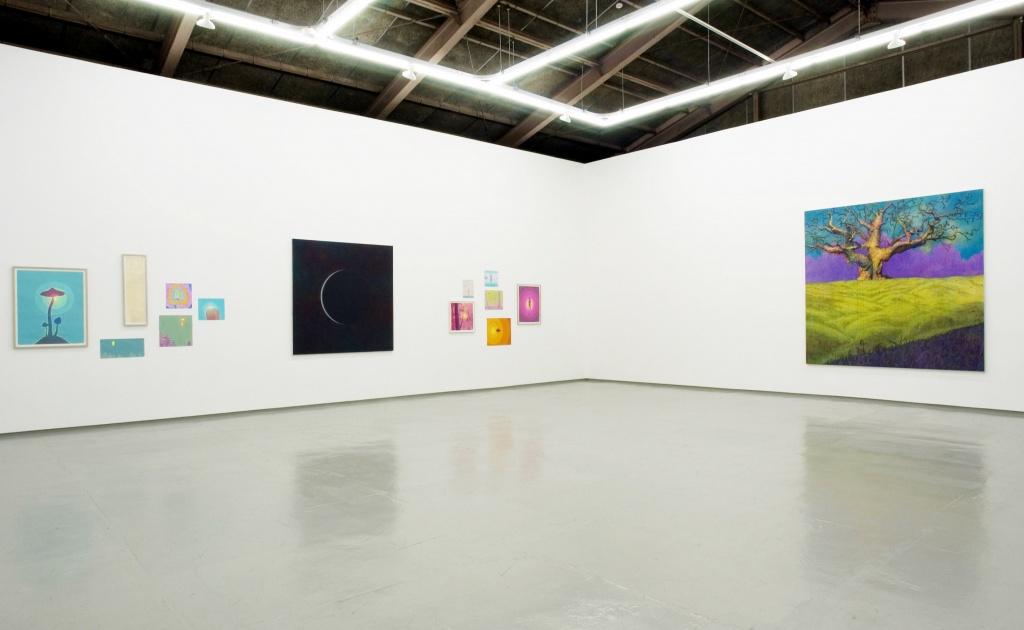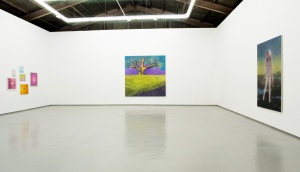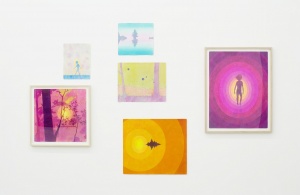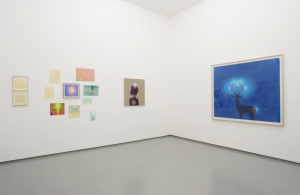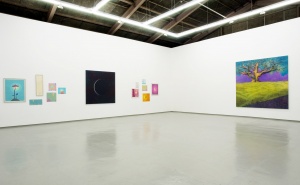Introduction
In Fukui’s works, there is always a certain tranquility that expands in the imaginary worlds. This may occur in a series of abstract canvases or maybe in a motif that illustrates a very concrete story, but what we cannot comprehend is the viewpoint of the artist. There is a sense of separation/distance between the depicted worlds and the artist, Fukui. We can immediately feel that the works are full of hints: they are visible in the paintings of the young girl stretched out in the forest, the mushroom silhouette, and the other entrance in a room. If we, however, try to speculate about the meaning of these paintings, we are unable to enter the paintings further.
The 2001 exhibition Morning Glory featured a series of strange imaginary scenes that lacked the extreme details. At first glance, the work titled “The Sea Serpent” displayed a close-up of crumpled bits of paper scattered on the floor. However, as the name implies, the use of contrast and color resulted in an abstract CG-like image that encouraged us to view it as an optical illusion that seemed to be widening.
In his next exhibition Bedroom Paintings, Fukui presented a more concrete motif, but the world had more pronounced and dynamic abstract qualities. In his work, “Phantom Pass”, a flower-patterned blanket formed a soft mountain range. This existed as both a blanket and mountain range simultaneously, so in our metaphysical world, there was a slight dizzying effect. In the work “Namakemono” clothes placed on a desk existed as a small range of mountains. The background appeared to be a cloudy sky, but if it were the real sky, we would be contemplating a desk that would exceed our own height and a miniature mountain range would be just barely visible. In the 2004 exhibition, teenage ghosts (and other scary stories) he took a turn from the painted canvas to focus on detailed brushwork. For this, he created a series of continuous images that resembled a movie still. These depict a girl in a forest, a deer in a forest, and a mysterious fur-covered work formed another world where the forest was cosmically linked. The light colors splashed around the field of view covered the beautiful material. The overpowering strength of the scene one can’t help it if thoughts of these works are like a parallel world float to the surface of one’s mind. Nonetheless, however, the absence of warmth on this absolutely clear world made it feel that it could only be a structured world.
Concept
In the new work titled “arrival gate” a sliver of light illuminates a darkened Earth, which is centered on a background of dark space. This is not the lively well-known view of Earth from photographs, but is the faint silhouetted image of the Earth during an eclipse. Filled with a foreground of grassy hills and a tree towering in the background, the large canvas in the work “Metatron” could be one’s first sight on Earth after arriving long, long ago ? emanating a strange feeling of deja vu. Titled “Botanist,” an androgynous nude, floating in front of a celestial background like that of the Mona Lisa, has a spiritual motif. And while it has no connection to Fukui’s work; thus far, it is actually more closely resembles the realm of science fiction. The repeating series of mushrooms aims to inspire thoughts of poison or hallucinations. The playful artist’s perspective manipulates reality to show us a more advanced world than our own world, Earth. Fukui said that he wanted to try to express the power and joy of paintings as they existed before movies by including the history prior to us – to create a world that is real, but one we cannot be close to. This exhibition consists of nine new paintings and drawings.
Artist Biography
Born in Aichi prefecture in 1966, Fukui graduated from the Oil Painting Department of Tokyo National University of Fine Arts and Music in 1989, and he is currently based out of Tokyo. His first exhibition at the Tomio Koyama Gallery was in the group exhibition Morning Glory, which was curated by Yoshitomo Nara. Since then, he has also had solo exhibitions Bedroom Paintings (2002) and Teenage Ghosts (and other scary stories) (2004). After a two-year absence, this is his third solo exhibition.

